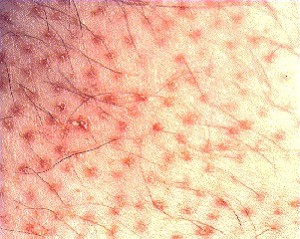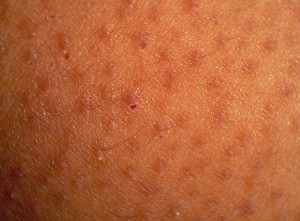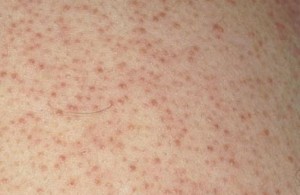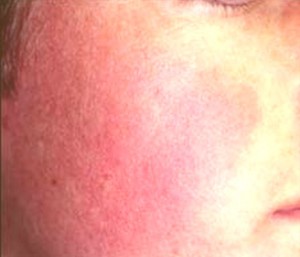There are plenty of skin problems that can ruin a person’s dream of having beautiful skin and keratosis pilaris is one of them. This particular skin condition not only alters the appearance of the skin but also destroys its texture. It occurs when the skin produces too much keratin which gathers around the hair follicles. Keratosis pilaris may not lead to other serious problems but it greatly affects the self-esteem of an individual.
There may be no specific treatment for keratosis pilaris (KP) but precautionary measures and prescription medications are available to improve the appearance and texture of the affected skin. Although there are times that KP lingers for longer periods of time, it usually clears on its own.
What is keratosis pilaris?
Keratosis pilaris or KP is a follicular disorder characterized by red, small and rough bumps creating a goose bump look. These red bumps are largely found on the back, buttocks, legs, arms and on the cheeks at times. It may be completely harmless but it is cosmetically displeasing which could lower a person’s self-confidence substantially. There are three types of KP and these are:
- KP Rubra
This type of KP has an inflammatory component which is the reason why the small bumps are swollen or red. KP rubra is very obvious during winter months.
- KP Alba
This is the most common type of KP which is characterized by uneven and painless bumpy skin.
- KP Rubra Faceii
This is the type of KP that occurs on the face that looks like a small rash or lesion.
Who usually gets Keratosis Pilaris?
Anyone can be afflicted by KP but studies showed that children and teenagers make up the highest percentage of people suffering from KP at around 50% to 80%, and about 40% of adults. In addition, keratosis pilaris is more prevalent among girls than boys and often strikes within the first ten years of life and gets worse upon reaching puberty. Furthermore, the majority of those affected also has family members and relatives suffering from KP as well. Those with extremely dry skin and have been suffering from atopic dermatitis are also susceptible to KP.
Keratosis Pilaris causes
The real culprit of keratosis pilaris remains unknown, though scientists believed that it has something to do with too much production of keratin. Keratin is a milky-white hard protein that shields the skin against harmful substances by forming a scaly blockage on the hair follicle opening. Overproduction of keratin results in the complete blockage on the opening of hair follicles which gives rise to patches of bumpy, rough skin. Some people are genetically predisposed to KP. Keratosis pilaris is also associated with other conditions such as:
- Atopic dermatitis
- Ichthyosis Vulgaris
- Eczema
- Allergies
- Dry skin
- Rhinitis
- Seasonal allergies
- Asthma
Keratosis Pilaris symptoms, how to identify ?
A person will know that it is KP when he or she notices a patchy rash of tiny red bumps numbering from 10 to 100 rough bumps scattered on the affected area. The region where the tiny red bumps are found has a fine jagged texture similar to sandpaper, which may come with a light-red halo signifying inflammation. A tiny coiled hair can be trapped under the patchy bump and may appear with acne and white heads. When KP appears on the cheeks, the person will have pink and flushed cheeks studded with small bumps.
Is Keratosis Pilaris contagious?
KP is caused by the overproduction of keratin not by virus, bacteria or fungus, therefore it is not transmittable. Infected people cannot spread it to others but some are more prone to having it than others. Complications due to KP rarely occur, although those who have it may suffer from momentary hyperpigmentation or skin discoloration following an episode of inflamed tiny bumps. Permanent scarring, though rare, can occur as a result of aggressive treatments, other skin inflammation and deep picking.
Keratosis Pilaris treatment
There is no specific treatment method or medicine for keratosis pilaris because it sometimes clears on its own even without treatment. However, there is a long list of creams and lotions known to be effective in treating KP and it is important for anyone thinking of using any of them to understand that their effectiveness differ from one person to another. Some of the popular treatment options for KP include:
- Steroids
They are used for stubborn cases of KP to limit the gravity of inflammation and redness of the skin. However, this should only be used with the doctor’s prescription because it carries a number of disadvantages.
- Topical creams and lotions
Creams and lotions that contain tretinoin and vitamin A, as well as those made with adapalene crystals are known to be effective in treating KP.
Keratosis pilaris is a relatively common skin condition which is totally harmless. The affected individuals cannot pass it to other people and proper skin care is the finest shield a person can take in order to prevent it from getting worse.
Keratosis pilaris pictures
Check out the images and photos of Keratosis pilaris and see how they affect the skin.




Today, with the fast chosen lifestyle that everyone leads, credit cards have a big demand throughout the economy. Persons throughout every arena are using the credit card and people who are not using the credit cards have prepared to apply for one. Thanks for expressing your ideas in credit cards.